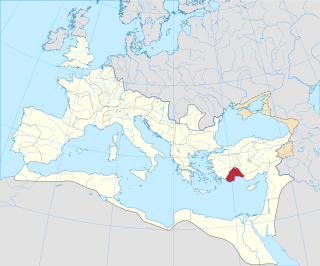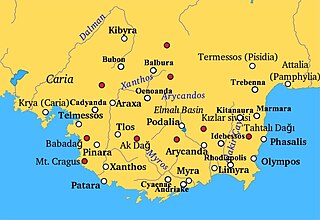Related Research Articles

Olympus or Olympos was a city in ancient Lycia. It was situated in a river valley near the coast. Its ruins are located south of the modern town Çıralı in the Kumluca district of Antalya Province, southwestern Turkey. Together with the sites of the ancient cities Phaselis and Idyros it is part of the Olympos Beydaglari National Park. The perpetual gas fires at Yanartaş are found a few kilometers to the northwest of the site.

Patara was an ancient and flourishing maritime and commercial city that was for a period the capital of Lycia. The site is located on the Turkish coast near to the village of Gelemiş, in Antalya Province.

Lycia and Pamphylia was the name of a province of the Roman empire, located in southern Anatolia. It was created by the emperor Vespasian, who merged Lycia and Pamphylia into a single administrative unit. In 43 AD, the emperor Claudius had annexed Lycia. Pamphylia had been a part of the province of Galatia.

Trebenna (Τρεβέννα) or Trabenna (Τραβέννα) was a city in ancient Lycia, at the border with Pamphylia, and at times ascribed to that latter region. Its ruins are located east of the modern town Çağlarca in the Konyaaltı district of Antalya Province, Turkey. The site lies 22 km to the west of Antalya.

Kitanaura was an ancient city in Lycia. Its ruins are located near Saraycık, a small village in the Kumluca district of Antalya Province, Turkey.
Mastaura was a town in ancient Lycia and is not to be confused with Mastaura (Caria).

Nisa, also Nyssa (Νύσσα) or Nysa (Νύσα) or Neisa (Νείσα), was a town in ancient Lycia near the source of the River Xanthus.
Corycus was a Greek port city in ancient Lycia. The location of the city has not been determined with certainty. The Barrington Atlas of the Greek and Roman World places the city at 36°26′10.1″N30°28′42.8″E. This is a short distance north of the modern town Çıralı in the Kumluca district of Antalya Province, Turkey.

Marmara was a town of ancient Lycia, whose inhabitants put up a ferocious defense to Alexander the Great during his invasion. The name does not appear in history, but the ethnonym is cited by Diodorus Siculus. The town's territory is called Mnarike in the Stadiasmus Patarensis, implying a town name of Mnara.
Cosara or Kosara was a town of ancient Lycia, that appears on the Stadiasmus Patarensis.
Kastabara was a town of ancient Lycia, which per the Stadiasmus Patarensis was 128 stadia from Tlos.
Kollyba was a town of ancient Lycia, which per the Stadiasmus Patarensis was on the road from Lycae to Pygela.
Korma was a town of ancient Lycia, which per the Stadiasmus Patarensis was the destination of a road from Acalissus.
Lyrnai was a town of ancient Lycia, which per the Stadiasmus Patarensis was in the territory of Octapolis and the destination of a road from Calynda.
Onobara was a town of ancient Lycia, which per the Stadiasmus Patarensis was the destination of a road from Trabenna.
Soklai, or Sokla (Σόκλα), was a town of ancient Lycia, which per the Stadiasmus Patarensis was on a road from Acarassus, and another from Podalia.
Trimilinda was a town of ancient Lycia, which per the Stadiasmus Patarensis was on a road from Balbura to Kibyra.
Kalabantia or Kalabatia (Καλαβατία) was a town of ancient Lycia, which per the Stadiasmus Patarensis was 24 stadia by road from Sidyma.
Elbessos was a town of ancient Lycia, which was mentioned in a treaty between Caesar and the Lycian League.
References
- 1 2 "Patara excavations start for the 25th time this summer". Hürriyet Daily News. 20 July 2013. Retrieved 13 February 2015.
- ↑ Christopher P. Jones (2001). "The Claudian Monument at Patara". Zeitschrift für Papyrologie und Epigraphik . 137: 161.